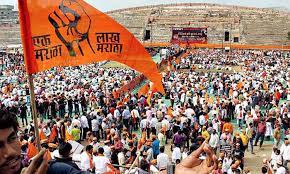
Maharashtra's latest Maratha Quota law
Maharashtra's latest Maratha Quota law
GS-2: Indian Polity
(UPSC/State PSC)
Important for Prelims:
Maharashtra State Reservation Bill-2024, Maharashtra State Backward Classes Commission (SCMBC), EWS, Indra Sahney case (1992).
Important for Mains:
Key points related to Maharashtra State Reservation Bill-2024, Maratha Quota Law, other reservation bills previously passed by Maharashtra government, Court decisions regarding Maharashtra Reservation Bills, Implications, Challenges, Conclusion.
06/03/2024
Why in news:
Recently, the Maharashtra Assembly has unanimously passed “Maharashtra State Reservation Bill, 2024”, a bill providing 10% reservation for socially and educationally backward classes.
Maharashtra State Reservation Bill, 2024:
- Passed on February 20, 2024, the bill provides for 10% reservation for the Maratha community in education and government jobs.
- The bill is based on a report by the Maharashtra State Backward Classes Commission (SCMBC), which found that as the Marathas, who constitute 28 per cent of the population of Maharashtra, face significant backwardness, it is justified to increase the reservation i.e. quota beyond the limit of 50 per cent.
- Principle of creamy layer will apply: Reservation under this Act will be available only to those people from socially and educationally backward classes who are not in the creamy layer category.
- Currently, 52 percent reservation is applicable in Maharashtra: SC (13%); ST (7%), OBC (19%), Nomadic Tribe A (3%), Nomadic Tribe B (2.5%), Nomadic Tribe C (3.5%); Nomadic Tribe D (2%); and Special Backward Classes (2%).
- Additionally, 10 percent is reserved for the EWS category, and with the addition of 10 percent for Marathas, the total reservation in the state will reach 72%.
Maratha Quota Law:
- Maratha quota law refers to a series of legislative and judicial actions in Maharashtra aimed at providing reservation in education and government jobs for the Maratha community.
- The Maratha community, a politically influential group in Maharashtra, has been advocating reservation, arguing that a significant portion of their population is economically and educationally backward.
- The issue of reservation for the Maratha community vis-à-vis Other Backward Classes (OBCs) in Maharashtra, India has been an important and controversial topic in recent years.
- This complexity arises from the overlapping demands for socio-economic upliftment by different communities within the state, each with its own historical background, socio-economic status and political representation.
Other reservation bills previously passed by the Maharashtra government:
- The demand for reservation by the Maratha community has been an issue in Maharashtra for a long time. Despite being politically influential, many in the community continue to claim to face limited access to economic facilities, education and employment opportunities. To accomplish this, the Maharashtra government has passed reservation bills twice in the past:
- In the year 2014, the Maharashtra government had announced 16% reservation for Marathas under a new category called Educationally and Socially Backward Class (ESBC).
- In the year 2018, the Maharashtra Legislature passed a bill proposing 16% reservation for Marathas under the Socially and Educationally Backward Classes (SEBC) Act, 2018.
Court Judgments Regarding Maharashtra Reservation Bills:
- Bombay High Court's decision: The Bombay High Court, while accepting the need for Maratha reservation, said that 16% quota was not appropriate and suggested that 12% quota in education and 13% quota in jobs would be more appropriate.
- Supreme Court intervention: Citing the Indra Sawhney case (1992), the Supreme Court had said that the reservation implemented by the Maharashtra government violates the 50% limit of reservation. But the Maharashtra government, while defending the reservation, had justified the backwardness of the community.
- 2021 Supreme Court Decision: The Supreme Court of India struck down a Maharashtra law granting reservation to the Maratha community in admissions and government jobs, saying it exceeded the 50% cap on reservation and did not meet the criteria to breach the cap.
Implications of Supreme Court's decision:
- The Supreme Court's decision was a major blow to the Maratha community's demand for reservation. It reaffirmed the 50% cap on total reservations and emphasized the need for a strong justification for exceeding this cap, which the Maratha quota did not meet according to the court.
- Following the decision, the Maharashtra government and various Maratha organizations are exploring alternative ways to provide support to the community, including educational and economic measures. The issue remains a controversial and politically sensitive matter in Maharashtra, reflecting the complex interplay of caste, politics and social justice in India.
Challenges of Maratha Quota Law:
- The Maratha community's demand for reservation is partly driven by perceived economic difficulties, especially in the agricultural sector, and a desire for better representation in education and government jobs. They argue that their numerical strength does not translate into socio-economic advantage.
- One of the significant concerns has been the potential impact of Maratha reservation on the existing OBC quota.
- There are apprehensions among OBC communities that including Marathas in the OBC category or creating special reservation for them may reduce the opportunities available to current OBC beneficiaries.
- This has created tension between communities, with OBC groups fearing that reservation may adversely affect their share in education and employment.
Conclusion:
- The Maratha quota law, Maratha vs OBC highlights the complexities of reservation politics in India, reflecting the challenges of balancing socio-economic equality, legal framework and aspirations of diverse communities.
- The Maratha quota law potentially underlines the need for a nuanced approach to reservation through a more detailed socio-economic assessment and at the same time ensuring the social and economic interests of the needy people of the Maratha community.
Source: The Hindu
-----------------------------------------------------
Mains Question:
What is the latest Maratha quota law of Maharashtra? Analyze the challenges and decisions of the Supreme Court related to this quota law.